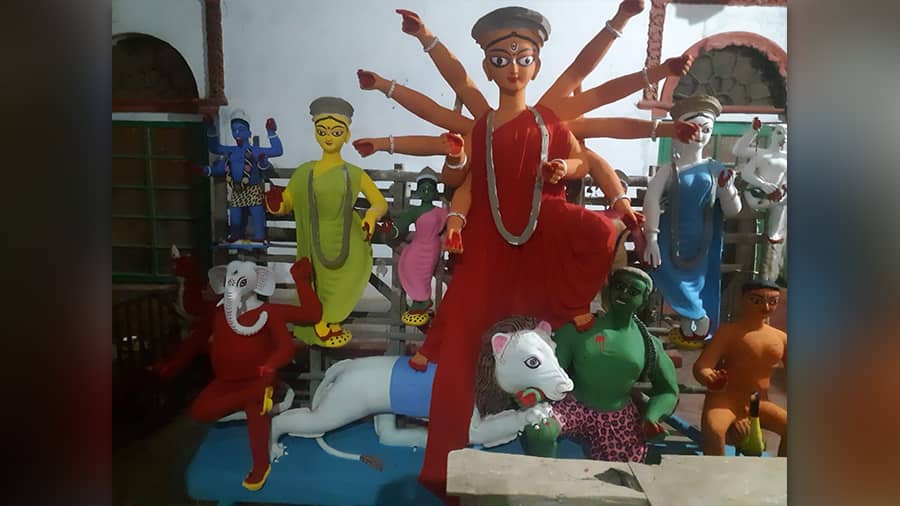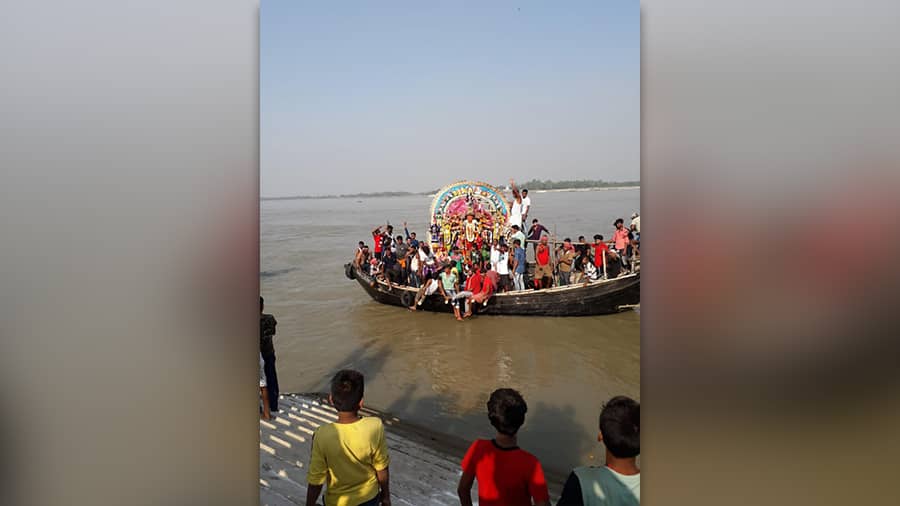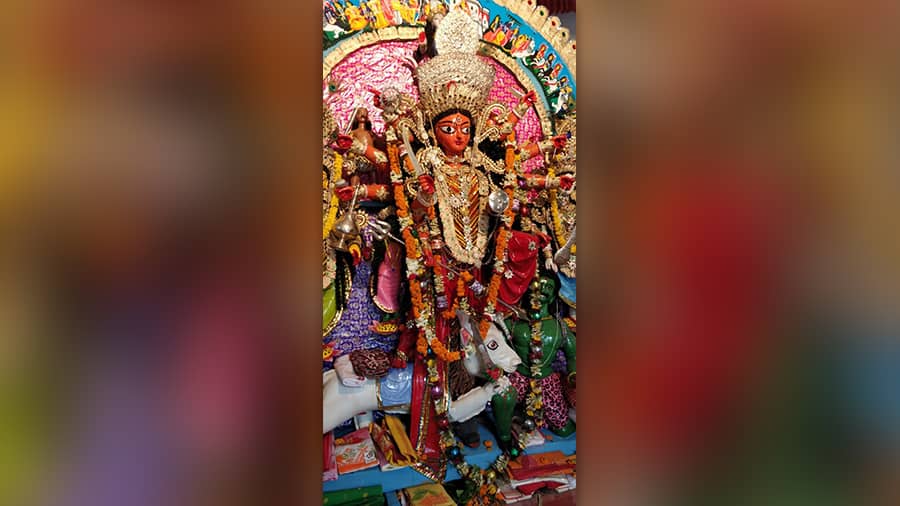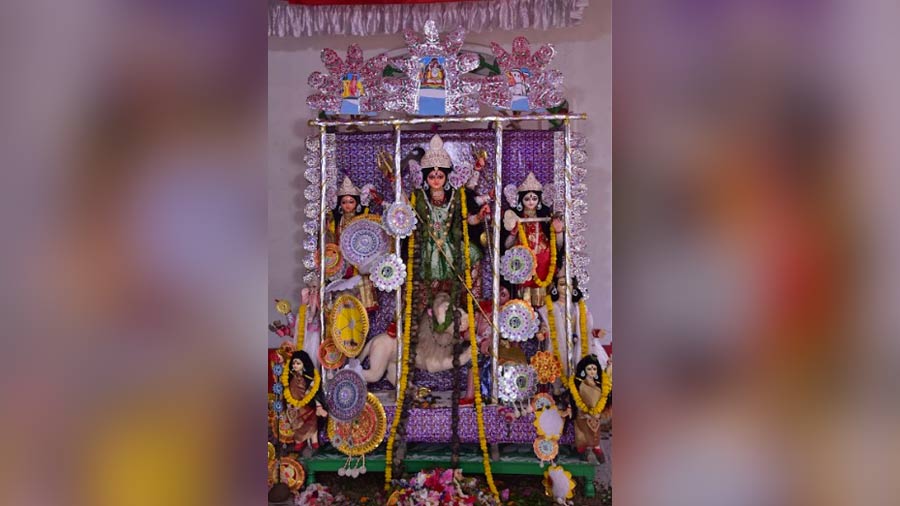On the banks of the Ganges, near Santhal Pargana of the West Bengal-Jharkhand border, a 350-year-old Durga Puja still upholds a royal family’s century-old heritage and customs besides bridging two communities in one festival.
The Durga Puja of the Roy family, the royals of Dhulian in Murshidabad, is held in Kanchantala village, where the family had migrated from Maluchi village of Bikrampur in East Bengal. It was during this period, in the 18th century, the Mughal capital of Bengal was shifted to Murshidabad from Dhaka. Soon, the family changed their original surname, Bose, to Roy, which was actually a royal title bestowed upon them by the Nawab of Murshidabad.
After the Battle of Plassey in 1757, the family received a raw deal from the East India Company for being close to the Nawab of Murshidabad. About 100 years later, the family finally gained the confidence of the British rulers when they helped them tame the Santhal uprising in 1855 . That was when the family’s good days started.
An ancestor of the family, Babu Jagbandhu Roy, invested money in the indigo business with Gillander & Co. and made a huge fortune. Such was his newly gained status that his younger son, Parbati Charan Roy, was invited to attend the first Delhi durbar, representing zamindars of Bengal, when Queen Victoria was decorated with the new title as the “Empress of India” at this imperial assemblage in 1877.

The Roys’ palatial house in Kanchantala village
The family Puja of the Roys initially shifted from Maluchi village of East Bengal to Dewanpur and then finally to Kanchantala village. The Roys had built a palatial house there. The same palace still hosts the Durga Puja with some exceptional rituals, where all the family members from across the globe gather with the local people and a large part of them are Muslims.
The puja is done according to “Devi puran staba” and unlike other Durga Pujas, the badhan is done 15 days ahead of Navami. Puja starts thereafter.

The making of the idol in progress
The idol of this family also draws attention for its features. The idol is now made by the President’s award-winning sculptor Shyam Sundar Pal, whose family has been doing the job in this house for generations. Here, the idol features an exceptional chalchitra, where MakarBahini Ganga is placed just above Durga on the centre of the kathamo.
Known as Baish Putuler Pujo (the puja of 22 idols ), the idol is an assembly of many gods and goddesses such as Kali, Nandi, Narasingha, Shiva, Ram, Laxman, Tara, Jaya, Vijaya along with common members of Durga family like Ganesh, Saraswati, Laxmi and Kartik. Worshipping so many idols on one platform during Durga puja is rare in Bengal.
The skin color of Durga is done in orange to match her name Atoshi, the colour of Shiuli flower’s tail.
Another amazing thing is that the snake in hand of Durga, known as Nagpash, is also offered as homage and its “praan prathistha” is done with all other idols.
Animal sacrifice still takes place, though it is a low-key affair now. However, the young generation is now planning to discontinue this gory affair.

The women of the family perform a ritual
There was another ritual practised till mid 1990s, where the matriarch of the family made a small cut on her chest and offered the blood to Devi during Sandhi puja. The blood was taken on a leaf and then placed at the feet of the Devi.
Over the years, the family got divided into many branches and settled in different corners of the world. But still everybody participates in whichever way possible. A grand celebration is organised by the family members and there’s food, song, dance, laughter for the next five days of the Puja.
Now, Sudip, Tridib, Tamal and Amit Roy — grandsons of Samarendranath Roy — who take all the initiatives to organise this Puja every year. It was Samarendranath Roy, who once convinced Babu Jagjivan Ram, his good friend, to build a new railway station at Dhulian.
Hundreds offer pushpanjali at the Roy bari and many families of the village still send their pujar dala here during Durga Puja.

The idol taken on a boat for immersion
The immersion of the idol is another great sight to behold. The idol is never carried on any motor vehicle, but on the shoulders of the villagers who walk nearly a kilometre to reach the banks of Ganga where the entire population of the area gather to watch the event. Most of the people here happen to be Muslims, and they, along with others, bid a tearful adieu to the mother Goddess. The idol is then taken to the middle of the river on a boat for immersion and the Muslim boatmen enthusiastically participate in the process. At that moment, we get a real picture of communal harmony in this Murshidabad village.
Till the time Roy barir Maa is not immersed, no other idol of the locality is allowed immersion. This is done as a mark of respect to the family’s rich heritage. “Even this year, Rasul, a veteran boatman, has contacted me in advance and has asked for the contract,” said Sudip, before signing off.


